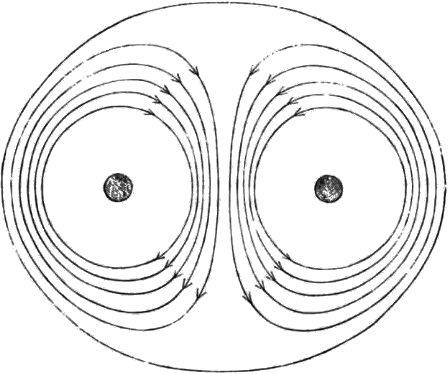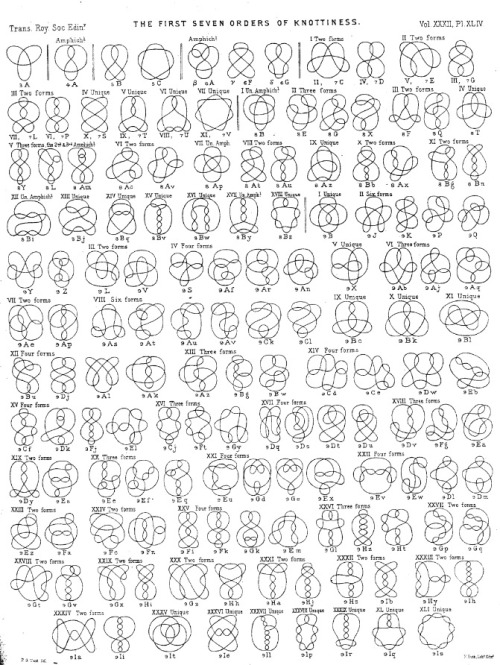JF Ptak Science Books Post 1541 (Part of the Series Blank, Empty & Missing Things.)
Embedding a circle in 3-D Euclidean space is another way of looking at a simple and substantial elements of human activities. Knots have played a large role in human history over a long period of time--not just for connecting things, or determining speed, but also in design, the appearance of, say, objects that would later be known as Borronean rings that appear in Tibetan Buddhism (endless knots as keys to infinity) to the Celtic knots (decorating, say, the Book of Kells).
Gauss did very early work (1)-as is so often the case-- on knot theory, as did William Thomson, Lord Kelvin,who visualized atoms as knots in the aether and who was perhaps inspired by P.G. Tait's experiments on smoke rings (2) and who in turn had been influenced by a paper of Hermann von Helmholtz on vortex-rings in incompressible fluids, and organized the stability of chemistry around this pricnipal. In turn P.G. Tait based his very solid work on knot theory in 1867 on this work of Kelvin and von Helmholtz. .(Kelvin's theory (3) was rather well received for several decades until it was not, but it did enjoy the support for a time by J.C. Maxwell. Kelvin was a brilliant man who I think is too often remembered for some of the few hundreds of the millions of words that he wrote and lectured, not the least of which were his pronouncements at the every end of the 19th century on the impossibility of heavier-than-air flight.) Tait--who also co-authored a very well respected textbook on Natural Philosophy with Kelvin--moved on to firmly establish knot theory and on the elements that makes knots different, formulating tables on how knots form, and in essence believing that he was fabricating a table of the elements. All of this work suffered a fatal blow when the great Michelson-Morely experiment (1887) (4) failed to detect the luminiferous aether.
- [The first page of how knots come to be as they appeared in P.G. Tait's earliest work, though he by necessity kept the investigations to relatively minimal degree: "We find that it becomes a mere question of skilled labour to draw all the possible knots having any assigned number of crossings. The requisite labour increases with extreme rapidity as the number of crossings is increased. ... I have not been able to find time to carry out this process further than the knots with seven crossings. ... It is greatly desired that someone, with the requisite leisure, should try to extend this list..."]
This was the beginning of the tabulation of knots, found in Tait's beautiful work. To date some 7 billion tabulations have been identified, a number nearly equal to the of the world's population. Knot theory has taken shape as an area of study within the field of topology, which was developed in the 1850's through the 1870'sby Riemann/Listing/Mobius/Klein and then which received its algebraic foundation by Henri Poincare (5) just af ew years after Michelson-Morely and in the same year as Roentgen's x-ray, 1895.
Notes
1. The Gauss linking integral,1833, carried forward by Johann Benedict Listing.
2. An interesting modern recreation of the Tait smoke ring experiment can be seen here. See malso: Silliman, Robert H., William Thomson: Smoke Rings and Nineteenth-Century Atomism, Isis, Vol. 54, No. 4. (Dec., 1963), pp. 461–47
3. Lord Kelvin, Sir William Thomson, "On Vortex Atoms", Proceedings of the Royal Society of Edinburgh, Vol. VI, 1867, pp. 94-105. Reprinted in Phil. Mag. Vol. XXXIV, 1867, pp. 15-24.

--It was also Kelvin (along with A.A. Michelson) who spoke on the finiteness of physics, with Kelvin in particular stating at a British Association for the Advancement of Science meeting in 1900 that there would be nothing new in physics, and that all that was left was measurement. I seem to remember a story about one of Einstein's uncle's (?) warning him against going into physics because there was nothing left new to do...I can't remember if this was before or after Roentgen. In any event, Kelvin's statement was five years after Roentgen, but it didn't stop him from making his claim.
4. On the Michelson-Morely experiment.
5. H.Poincaré, "Analysis Situs", J. Ec. Polytech ser 2, vol 1 (1895) 1-123.
--The Journal of Knot Theory and Its Ramifications was founded in 1992, establishing a journal devoted purely to knot theory.



Comments